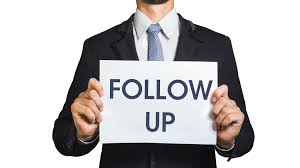Sales reps make two classic blunders when following up with leads by email. Either they don’t do it. Or they do it so poorly that they may as well as not do it. How effective are your email follow-up efforts? Complete this checklist and find out.
Timing
- I send a follow-up email within 10 minutes of talking with a lead on the phone
- I send a follow-up email within 10 minutes of leaving a voicemail with a lead
- I send a follow-up email within 24 hours of talking with a prospect at a trade show
Sender
- I send my follow-up emails from my business email account
- The “From” email address in my emails includes my name
- My follow-up emails are never sent from a “no reply” email address
Subject lines
- The subject lines in my follow-up emails are short, designed for mobile reading
- I personalize my subject lines to make them relevant to each lead
- I put the lead’s name in the subject line on occasion, unless doing so looks cheesy or creepy
- I place the most important words at the beginning of my subject lines
- My subject lines arouse curiosity and compel recipients to open
- I never sell in my subject line
- My subject lines communicate relevance or timeliness or both
- My subject lines never give away what the entire email is about
- I know the power of questions, and use them in my subject lines
- I avoid words that are likely to trigger spam filters, such as free, buy, act now, last chance
- I never use all caps in my email subject lines
First sentence
- I address my reader by name
- I understand the power of stories, and often begin my emails with a powerful anecdote
- I understand the power of arresting statistics, and often start my emails with a stat that grabs attention
- I grab attention within the first 10 words
- My first sentence is about the reader
- I never start my emails with “I,” “me” or “my company”
- The first sentence in my emails arouses curiosity and gives leads a desire to keep reading
- My first sentence establishes continuity with my last email or the last contact I had with a lead, whether that was a meeting, a call, a previous email, or an action that the lead took, such as download something from my company website
First paragraph
- My follow-up emails use the first few sentences to identify a pain or describe a challenge
- My first few sentences never offer a solution before first describing a pain or challenge
- My first few sentences establish that my email is relevant, timely and helpful
- My first few sentences are short
- I get to the point quickly
Solution
- I describe the product or service I am offering using language that communicates benefits
- I describe the solution I am offering in one short sentence whenever possible
- I offer a solution that takes away the pain or meets the challenge I just mentioned in my opening sentences
Offer
- Knowing that the majority of leads are not ready for a sales conversation, I include a soft offer in my follow-up emails, such as a helpful resource to download or a relevant blog post to read
- Knowing that some leads are ready for a sales conversation, I include a hard offer in my follow-up emails, such as a free consultation, free trial or over-the-phone assessment
- I end every email with two calls to action, one for the soft offer (“Download your free guide here”) and one for the hard offer (“Call me today to request a quote”)
Signature
- I end my emails on a cordial note
- My follow-up emails include a signature block that contains all the contact information a lead needs to know, including my name, title, company, email address, phone number and extension, office address and social media handles
Cadence & Mix
- The emails in my follow-up sequences follow a natural cadence that meets the needs and expectations of my lead and where they are in their buyer journey (not too many too often, and not few too infrequently)
- I do not reply on email alone in my lead follow, but use the phone, LinkedIn outreach, video calls and meetings as well

Recent Comments